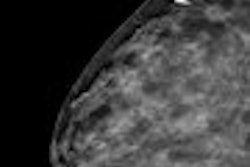The sensitivity and reproducibility of computer-aided detection (CAD) software is consistently high for breast cancer detection in both initial and short-term follow-up digital mammograms, according to research published in the January issue of Radiology.
"Reproducibility was significantly higher for true-positive CAD marks than for false-positive CAD marks," wrote a team of South Korean researchers led by Dr. Seung Ja Kim of Seoul National University Medical Research Center.
The study team sought to retrospectively evaluate the sensitivity and reproducibility of a CAD system used in serial digital mammograms in breast cancer patients. Using a group of women with known breast cancer between July 2004 and November 2005, the researchers selected 93 consecutive patients who had undergone digital mammography twice in less than two months, had a visible malignant lesion in both craniocaudal and mediolateral oblique views, and had no changes in findings during follow-up (Radiology, January 2008, Vol. 246:1, pp. 71-80).
All women were scanned using a Senographe 2000D full-field digital mammography (FFDM) system (GE Healthcare, Chalfont St. Giles, U.K.). The mean interval between exams was 23 days, and there were 119 visible lesion components (including 70 masses and 49 microcalcifications).
One of the two attending radiologists who interpreted the initial studies then applied version 3.1 of ImageChecker M1000-DM CAD software (Hologic, Bedford, MA) to both the initial and follow-up studies.
Two radiologists with three to six years of breast imaging experience then analyzed the locations of the CAD marks corresponding to mammographically detected and histopathologically confirmed cancerous lesions. They then determined by consensus whether CAD marks indicated the malignancy location.
The CAD system led to an overall sensitivity of 95% (113 of 119 lesions) in the initial FFDM exam, and 93% (111 of 119) in the follow-up study. In detecting masses, CAD produced sensitivity of 91% (64 of 70 lesions) in the initial FFDM exam, and 89% (62 of 70 lesions) in the follow-up study. CAD also detected all 49 microcalcifications in both initial and follow-up studies.
The differences in CAD's performance between initial and follow-up FFDM studies were not statistically significant, according to the authors. The CAD software had overall false-positive mark rates of 0.29 per image in the initial study, and 0.27 per image in the follow-up exam.
Overall, the CAD results were considered reproducible 80% of the time for true-positive masses, 92% of the cases for true-positive microcalcifications, 9% for false-positive masses, and 8% for false-positive microcalcifications (p < 0.001).
By Erik L. Ridley
AuntMinnie.com staff writer
January 10, 2008
Related Reading
UnitedHealthcare postpones CAD decision, November 27, 2007
CAD vs. radiologist second reads: What's better for screening mammograms? November 16, 2007
UnitedHealthcare ponders cuts to CAD reimbursement, October 26, 2007
CAD still not out of the woods, despite Oregon payor's reversal, July 24, 2007
Oregon payor reverses stand, reinstates CAD payments, July 23, 2007
Copyright © 2008 AuntMinnie.com




















